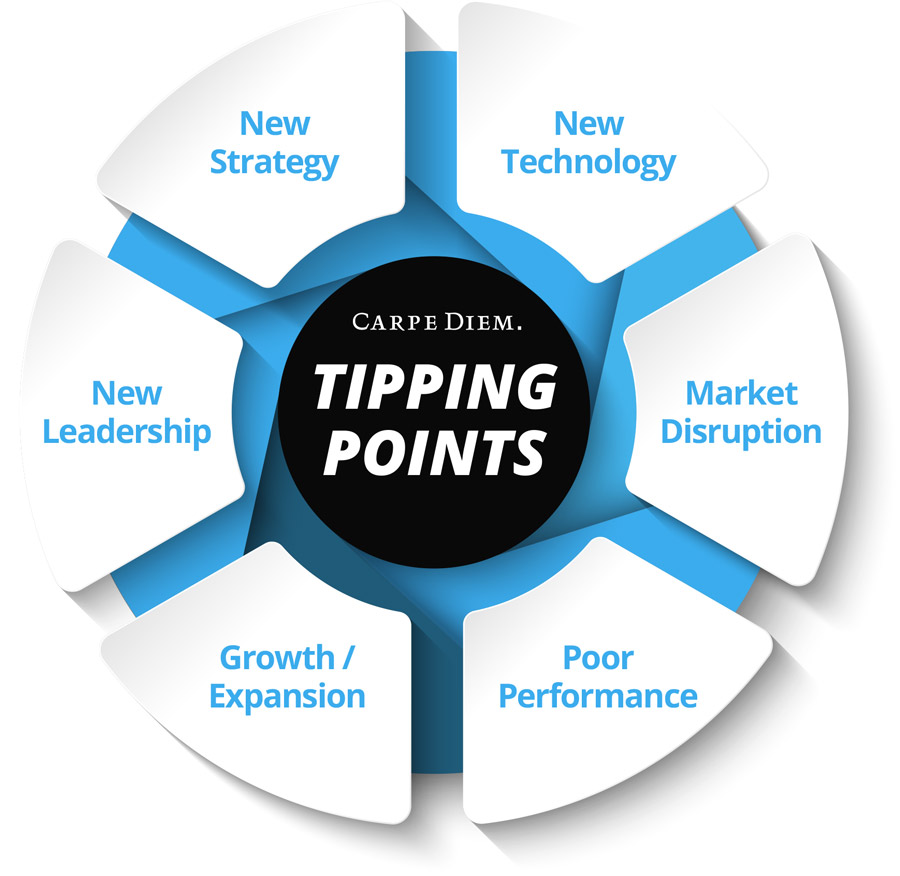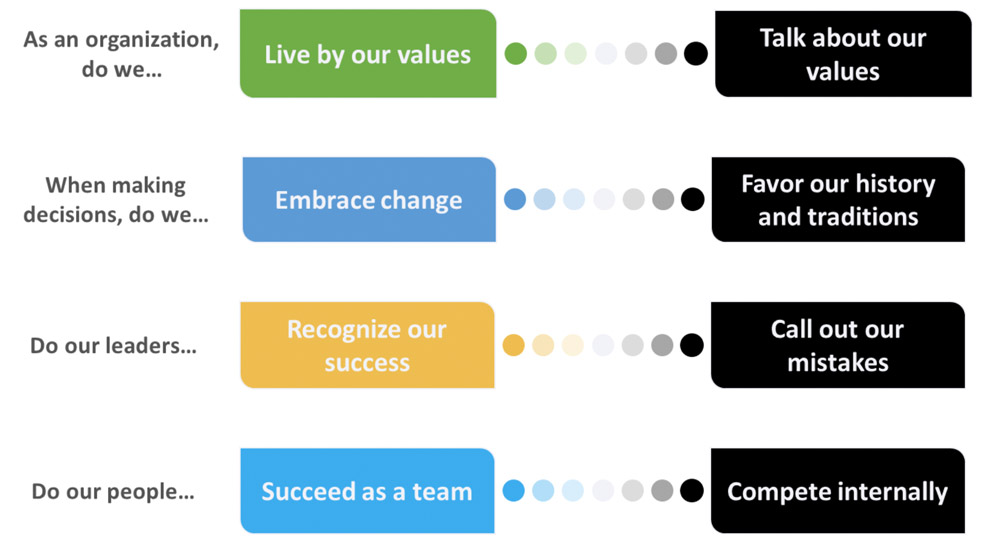Organizations reach various tipping points in their business or industry. When they do, they need the full power of their culture behind them – to rally the staff, enable their performance, and minimize burnout and turnover.

1
The call for cultural alignment
2
What traditional surveys can miss
3
Carpe Diem’s Organizational Personality Assessment
4
Leveraging the OPA
1. The call for cultural alignment
In more drastic cases, the tipping point may trigger the need for culture transformation. But that is typically a 3-5-year process with an estimated 15-20% rate of success.
There are two fundamental reasons why transformation efforts struggle.
- A lack of clear vision for change – The organization will launch a campaign around the desired cultural traits but will fail to acknowledge or address some of the key behaviors and processes that need to change to reach the desired state.
- A loss of momentum – The change effort is launched to great fanfare, but without a clear endgame or ROI. Without that return in mind, the effort starts to seem burdensome or overwhelming to stakeholders, ultimately giving way to other corporate priorities.
What most organizations should be targeting is greater cultural alignment, which allows them to make better use of the culture already in place. Alignment comes from hiring leaders who are a fit for the culture; helping new and existing leaders understand how they can better leverage the culture in their roles; and making small, timely enhancements to the culture in furtherance of a key change or improvement initiative – e.g., being quicker to market with a new idea or product, successfully integrating AI into operations.
A benefit of alignment over transformation is that it reduces the scope and accelerates the timeline of the change effort, while the tie back to a specific initiative creates a greater sense of urgency around the change. There are opportunities for quick wins from the process, including the success of the new executive hires and success of the underlying change or improvement initiative. This helps to sustain the momentum around the culture work and increases the likelihood that any enhancements made to the culture they will extend beyond the parameters of the change or improvement initiative.
2. What traditional surveys can miss
To enable the alignment process, it is important to have a clear understanding of the current state culture. Organizations don’t always have a firm grasp on their culture, equating it with values or wrapping their definition around the one or two most dominant traits.
Traditional culture surveys can be helpful in this regard. Yet they have their limitations. These surveys tend to focus on a relatively narrow set of cultural traits and are designed to look for the presence or absence of those traits in the organization. Are we mission-oriented? Are we proactive? Are we collaborative?
There is a flip side to many cultural traits that traditional surveys don’t capture.
- A lower score around mission-orientation could highlight the fact that the organization isn’t active in its community, but it wouldn’t necessarily speak to a perception among employees that the organization prioritizes margin over mission.
- A lower score around collaboration could indicate that there is a lack of active collaboration in the organization, but it wouldn’t call out a situation where people feel they have to compete against colleagues to get ahead.
These alternative cultural traits aren’t always negative. Internal competition can, in the right circumstances, stimulate creativity and enhance performance. Being margin-focused (as opposed to mission-oriented) or reactive (as opposed to proactive) can also have its benefits. However, the alternative traits do tend to be less motivating or people friendly. As such, they pose a greater risk of disruption to the culture, particularly in times of change.
3. Carpe Diem’s Organizational Personality Assessment
With this in mind, Carpe Diem has recently introduced its new Organizational Personality Assessment. The OPA is a different kind of assessment that provides a quick but comprehensive view of the culture, highlighting a wide range of cultural traits. These traits cut across four different aspects of an organization’s “personality.”
- Organizational Priorities – what drives the organization at a foundational level
- Decision-Making Style – how the organization approaches its opportunities and challenges
- Leadership Style – how leaders position themselves in their roles and support their people
- Social Structure – how people work and interact with one another on the job
What differentiates the OPA is that rather than having participants rate each attribute on a Likert Scale (5 = strongly agree; 1 = strongly disagree), or force rank the different attributes on a list (from most to least prevalent), it asks participants to compare two contrasting statements about the culture, to see which is more accurate.
There are two advantages to this approach. By testing two different attributes on each question, the organization is able to cover more ground with the survey. And the nature of the statements allows the survey to probe deeper into the psyche of the organization, confirming cultural strengths while capturing more challenging or potentially disruptive traits.
Think about an organization that wants to become more innovative to enhance efficiency or reverse a recent decline in market share. Employees might be less inclined to submit ideas if they felt their achievements weren’t being recognized. However, they might be fearful of doing so if the organization had a history of focusing on the negative or calling out people for their failures or mistakes. This would make it far more difficult for the organization to achieve its objective. That fear would only be revealed through the inclusion of the alternative statement in the assessment.
4. Leveraging the OPA
Whatever the approach, a survey is only as good as the action taken on the results. Carpe Diem leverages the findings from the OPA into all three pillars of its consulting work – Leadership Acquisition, Leadership Development, and Leadership Advisory.
Leadership Acquisition – Culture Screen
For executive searches, competencies related to the core strengths of the culture are incorporated into the key criteria for the search. Carpe Diem develops questions and “listen for’s” around those competencies, to be built into the candidate interviews. Candidates are then rated for their fit to culture as an underlying factor of their evaluation. Carpe Diem also outlines potential challenges for the candidate, where their leadership style may not align with the culture, that can be addressed during onboarding or as ongoing coaching opportunities.
Leadership Development – Culture Scan
The OPA provides new leaders with a quick overview of the culture and the environment they will be walking into when they start the job. As part of Carpe Diem’s 90-day accelerated onboarding process, new leaders develop strategies on how they can best leverage the culture and where they should push for change with their teams or functions. Leaders also identify areas where they might need to tailor their own style or approach in to better fit the culture and build trust with team members.
Leadership Advisory – Culture Sweep
Here, the focus is on filling cultural gaps to better support the designated change or improvement initiative. The process starts by defining the “true north” objective of the initiative and mapping some of the key cultural attributes typically needed to drive that objective. Those attributes then become the focal point of the assessment and resulting action plan. In many cases, the cultural gaps identified involve longstanding issues around trust, communication, and accountability that are generating greater attention in light of the change or improvement initiative.


These market insights from Carpe Diem Global Partners are gathered from the firm’s extensive client work with Board, CEO, CXO, and CHRO leaders in public and private multinational companies. For deeper, custom insights, contact Craig Kamins at ckamins@carpediempartners.com.


